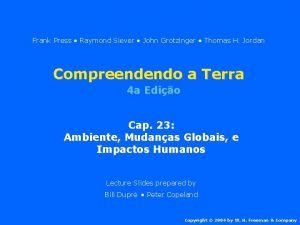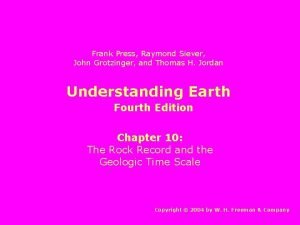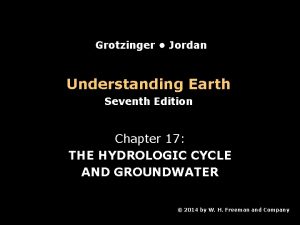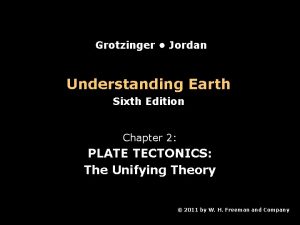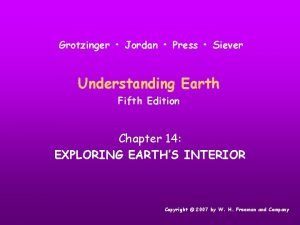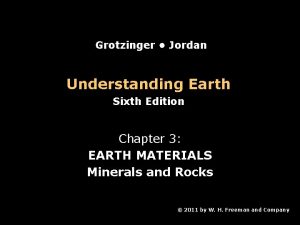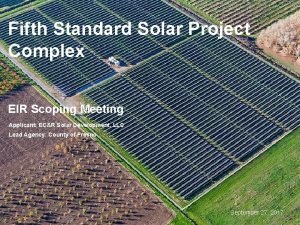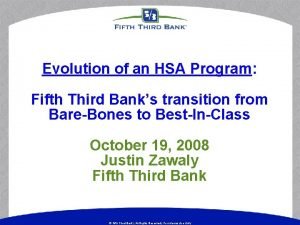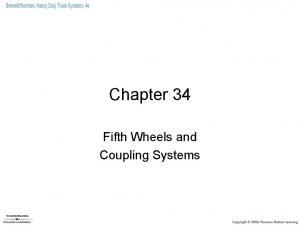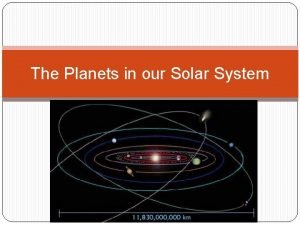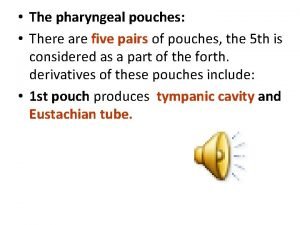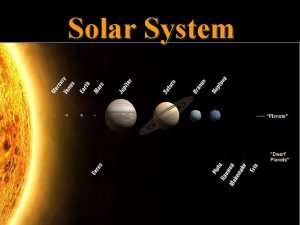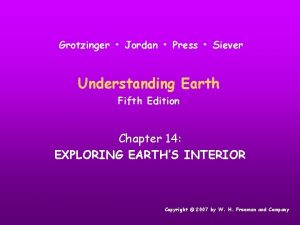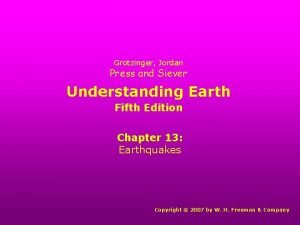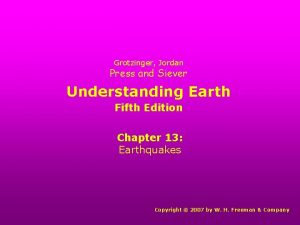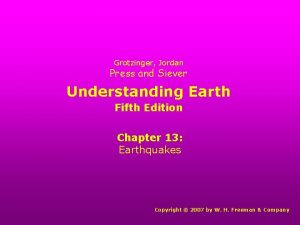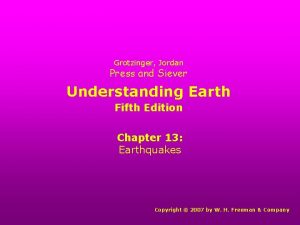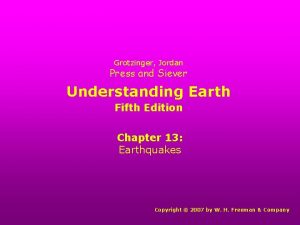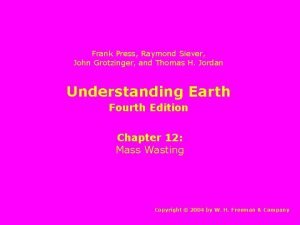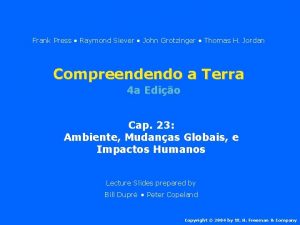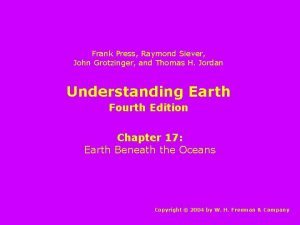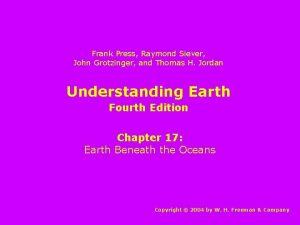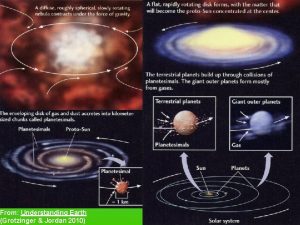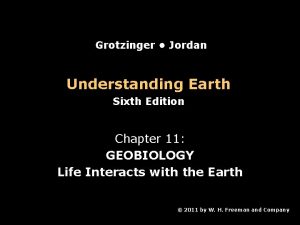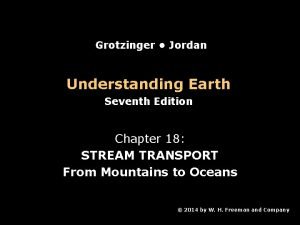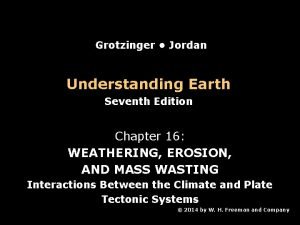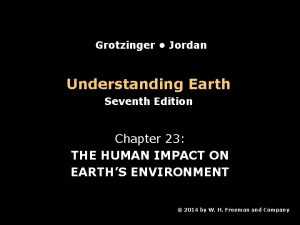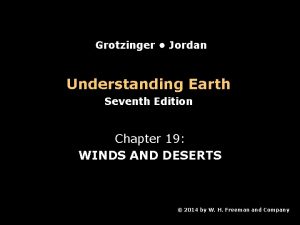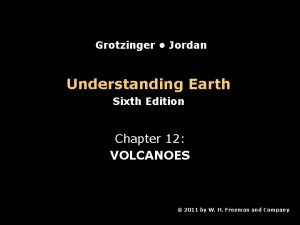Grotzinger Jordan Press Siever Understanding Earth Fifth Edition











































- Slides: 43

Grotzinger • Jordan • Press • Siever Understanding Earth Fifth Edition Chapter 14: EXPLORING EARTH’S INTERIOR Copyright © 2007 by W. H. Freeman and Company

Concepts we will use in this class In bold are the ones I consider most important Compressional wave Conduction Convection Core-mantle boundary Depositional remanent magnetism Dipole Geotherm Lower mantle Low-velocity zone Mohorovičić discontinuity (MOHO) Paleomagnetism Phase change Principle of isostasy Seismic tomography Shadow zone Shear wave Thermo-remanent magnetization

Lecture Outline 1. Exploring the interior with seismic waves 2. Layering and composition of the interior 3. Earth’s internal heat and temperature 4. 3 -Dimensional structure of the mantle 5. Earth’s magnetic field

Chapter 14 Exploring Earth’s Interior

Background facts about Earth’s Interior • The center of the Earth is about 6400 km below us … the deepest well is 10 km. • Heat inside the Earth drives the core’s geodynamo and the mantle’s convection. • Earth’s interior is explored by using information from seismic waves and their passage through the body of the Earth.

1. Exploring the interior with seismic waves ● Basic types of waves ● compressional (P waves) ● shear (S waves) ● Reflection and refraction

1. Exploring the interior with seismic waves ● Paths of seismic waves ● wave bending (refraction) ● shadow zones (P and S) ● reflection at internal boundaries

P-wave paths

S-wave paths

P- and S-wave paths from an earthquake

P-, S-, and surface wave paths: from focus to seismograph

P-, S-, and surface waves recorded on a seismograph

2. Layering and composition of the interior (a. k. a. Seismology model of Earth’s layers) ● crust and lithosphere ● asthenosphere ● mantle with internal phase change at 400 km

2. Layering and composition of the interior ● Seismology model of Earth’s layers (continued) ● core-mantle boundary ● core (inner and outer core)

Earth’s layering revealed by seismology

Earth’s mantle structure beneath an old ocean basin: S-wave velocity to depth of 900 km

3. Earth’s internal heat and temperature ● Heat flow through Earth’s interior ● conduction (lithosphere) ● convection (mantle and core)

Topography of mid-ocean ridges in the Atlantic and Pacific oceans

3. Earth’s internal heat and temperature ● Temperatures in the Earth ● geothermal gradient ● normally 20 to 30º C / km ● 1300 -1400º C at base of lithosphere ● 3000 -6000º C + in core

An estimate of the geotherm: temperature increases with depth in the Earth

4. 3 -Dimensional structure of the mantle ● Seismic tomography ● Earth’s gravity field ● The geoid

Mantle structure

Mantle structure

Mantle structure



The geoid: shape of planet Earth

5. Earth’s magnetic field and the dynamo ● Earth’s dipole field ● complexity of the magnetic field ● non-dipole field component ● secular variations in the field ● magnetic reversals

Change in the location of the North magnetic pole from 1600 to 2000

Earth’s magnetic field and the geodynamo

Earth’s magnetic field and the geodynamo

Earth’s magnetic field and the geodynamo

Earth’s magnetic field lines

Earth’s magnetic field reversals: Step 1

Earth’s magnetic field reversals: Step 2

Earth’s magnetic field reversals: Step 3

Earth’s magnetic field reversals: Step 4

5. Earth’s magnetic field and the dynamo ● Paleomagnetism ● records of magnetization ● thermo-remanent ● depositional remanent ● magnetic stratigraphy

Thermoremanent

Depositional remanent

Depositional remanent

Magnetic stratigraphy

5. Earth’s magnetic field and the dynamo ● Magnetic field and the biosphere ● magnetic orientation ● magnetic frame of reference ● field offers protection from the solar wind
 Atmosfera terrestre
Atmosfera terrestre Press and siever
Press and siever Understanding earth 7th edition
Understanding earth 7th edition Covergent boundary
Covergent boundary Understanding earth 5th edition
Understanding earth 5th edition Electron sharing
Electron sharing Principles of marketing fifth european edition
Principles of marketing fifth european edition Lazarus theory
Lazarus theory Fundamentals of corporate finance fifth edition
Fundamentals of corporate finance fifth edition Democritus atomic model diagram
Democritus atomic model diagram Molecular biology
Molecular biology Molecular biology
Molecular biology Human anatomy fifth edition
Human anatomy fifth edition Human anatomy fifth edition
Human anatomy fifth edition Understanding nutrition 13th edition rental
Understanding nutrition 13th edition rental Copyright
Copyright Understanding human differences 5th edition
Understanding human differences 5th edition Adler and rodman 2006
Adler and rodman 2006 Business essentials 12th edition
Business essentials 12th edition Adler and rodman 2006
Adler and rodman 2006 Understanding intercultural communication 2nd edition
Understanding intercultural communication 2nd edition Using mis (10th edition) 10th edition
Using mis (10th edition) 10th edition Report
Report Senge fifth discipline summary
Senge fifth discipline summary Fifth korotkoff sound
Fifth korotkoff sound Fifth gear loop the loop
Fifth gear loop the loop Ffa creed
Ffa creed Tis now the very witching time of night soliloquy
Tis now the very witching time of night soliloquy Fifth standard solar
Fifth standard solar Fifth labor of hercules
Fifth labor of hercules Fifth business archetypes
Fifth business archetypes Fifth paragraph of the ffa creed
Fifth paragraph of the ffa creed 5 3 bank hsa
5 3 bank hsa Oscillating fifth wheel
Oscillating fifth wheel Blessed are the merciful examples
Blessed are the merciful examples First korotkoff sound
First korotkoff sound Whats the fifth planet from the sun
Whats the fifth planet from the sun Lateral lingual swellings
Lateral lingual swellings La quinta disciplina the fifth discipline fieldbook
La quinta disciplina the fifth discipline fieldbook Solar system in circle
Solar system in circle One two three four five six to hundred
One two three four five six to hundred Saks vs neiman marcus
Saks vs neiman marcus Fifth ward junior high school
Fifth ward junior high school 5th sunday in advent
5th sunday in advent
